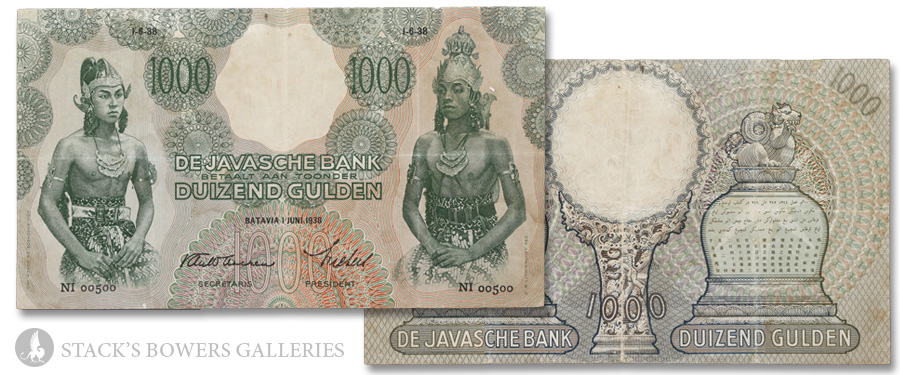
In world paper money there are some series of notes that have become such classics that we can almost compare them to the old masters in art. Notes that, due to their rarity, beauty or the circumstances of their creation are so desirable that every collector, from beginner to advanced, wishes to acquire them “one day.” In many instances, such notes are part of series for which some notes are more available, but once the easy notes are acquired, what is left are the great rarities. Such a series is the famed “Wayang” series of the Javasche Bank, issued in the Netherlands Indies, present-day Indonesia. Stack’s Bowers Galleries is proud to offer an extremely rare, fully issued example of the highest denomination of the series, the 1000 Gulden, in our October 2024 Hong Kong sale.
The Javasche Bank was founded in 1828 in Batavia (now known as Jakarta) and served as the sole issuer of paper money in the colony from that point onward (commercial banks were also allowed to operate in the colony but were not allowed to issue notes). Most 19th century issues are extremely rare. They featured basic designs at first, although by the last years of the century the designs had progressed to display intricate details including a view of Batavia on some notes. They also featured the portrait of Jan Pieterszoon Coen, an officer of the Dutch East India Company (VOC) and the chief founder of the Dutch commercial empire in the east. While conquering the region for the Dutch he massacred thousands of its inhabitants; Coen was known for the use of brute force. Despite this, in the early 20th century, he would become the primary design element on the bank notes of the Javasche Bank.
Coen was taken off the notes in 1933 when the Javasche Bank introduced the now famous Wayang series. Like the earlier notes, they were printed in the Netherlands at the firm of Johan Enschede & Zonen, who printed eight denominations ranging from 5 Gulden to 1000 Gulden. The initial three denominations were introduced in 1933 and 1934, followed by the higher denominations in 1938. Except for the 5 Gulden, which only featured one dancer, each note displays two Wayang dancers in traditional clothing. The notes would remain in circulation for quite some period and are sometimes seen with revolutionary handstamps. When the Javasche Bank was nationalized by the Indonesian government in 1951 to become the Bank Indonesia, most of the higher denominations that remained outstanding were withdrawn.
Wayang dancers are integral to traditional Indonesian puppet theater, particularly in the forms of Wayang Kulit, Wayang Golek, and Wayang Wong. Wayang Kulit features intricately carved shadow puppets manipulated behind a backlit screen, while Wayang Golek uses three-dimensional wooden puppets controlled by rods. In Wayang Wong, live actors perform in elaborate costumes, combining dance, drama, and music. These performances bring to life epic tales from the Ramayana and Mahabharata, serving not only as entertainment but also as a means of moral and spiritual reflection, all accompanied by the resonant sounds of a gamelan orchestra.
Examples of the higher denominations of the Wayang series of the Javasche Bank, especially the 200, 500 and 1000 Gulden are extremely rare in issued form. Not only did they represent significant purchasing power at the time of issue, but the print totals were small, and many were redeemed over time, either locally or in the Netherlands at the bank’s branch there. Specimens and color trial specimens are sometimes seen but are not common, further increasing demand for the higher denominations. The 1000 Gulden offered by Stack’s Bowers Galleries in the October 2024 Hong Kong auction is dated the 1st of June, 1938 and is graded Very Fine 25 by PMG, with a comment for minor repairs. It is an exceptional item from the colonial period of Indonesia and a note which we are proud to offer.
While consignments for the Hong Kong auction are closed, we are always accepting consignments for future auctions. To start the consignment process, please contact Stack’s Bowers Galleries at 800-458-4646 or email Dennis Hengeveld at [email protected].





